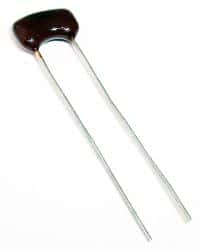 Mica, a phyllosilicate, is a group of hydrous potassium/aluminum silicate material. It is a rock-forming mineral exhibiting a two-dimensional sheet or layer structure. That means it is possible to split mica into thin sheets. The biggest advantage of mica is the excellent stability of its electrical, chemical and mechanical properties. This property makes mica a suitable material for use as a dielectric when making highly stable and reliable capacitors. Silver-mica capacitors are useful at high frequencies, because of their low resistive and inductive losses and high stability over time.
Mica, a phyllosilicate, is a group of hydrous potassium/aluminum silicate material. It is a rock-forming mineral exhibiting a two-dimensional sheet or layer structure. That means it is possible to split mica into thin sheets. The biggest advantage of mica is the excellent stability of its electrical, chemical and mechanical properties. This property makes mica a suitable material for use as a dielectric when making highly stable and reliable capacitors. Silver-mica capacitors are useful at high frequencies, because of their low resistive and inductive losses and high stability over time.
Delved in India, Central Africa and South America, the most commonly used are the muscovite and phlogopite mica. While the first has superior electrical properties, the latter has a higher temperature resistance. Mica capacitors are expensive as the raw material composition has high variation, requiring inspection and sorting. Silver mica capacitors have sandwiched mica sheets coated or plated with silver on both sides. The assembly is then encased in epoxy to protect it from the environment.
Tolerance and Precision
Among all types of capacitors, silver mica capacitors offer the lowest tolerances, as low as +/-1%. In comparison, ceramic capacitors have tolerances going up to +/-20% and electrolytic capacitors can have more.
The design of a silver mica capacitor does not allow any air gaps inside. Additionally, the entire assembly is sealed hermetically from the environment. That allows the mica capacitor to retain its value over long periods. As the assembly is protected from the outside effects of air and humidity, the capacitance of a mica capacitor remains stable over a wide range of temperature, voltage and frequencies. The average temperature coefficient of mica capacitors is around 50 ppm/°C.
Losses
Mica capacitors have a high Q-factor. This comes from the low resistive and inductive losses exhibited by these capacitors. That makes them a suitable choice for use at high frequencies, but it comes at a price – silver mica capacitors are expensive.
It is difficult for manufacturers to make silver mica capacitors of larger capacitance value. Typically, this ranges from a few pF up to a few nF. However, they can stand high voltages and mica capacitors are usually rated for voltages between 100 and 1000 volts. Special mica capacitors are rated up to 10KV and these are mostly for use with RF transmitters.
Applications
You can use silver mica capacitors wherever the application requires low capacitances, high stability and low losses – especially in power RF circuits – requiring very high stability.
You can also use silver mica capacitors in high frequency tuned circuits such as oscillators and filters. Pulsed applications such as snubbers also use mica capacitors as they can withstand high voltages. If cost is an important factor along with tolerance and low losses, you can replace mica capacitors with class I ceramic capacitors. Ceramic capacitors are available at a fraction of the price of mica capacitors.
Mica capacitors are available as surface mount versions as well. This offers several benefits over radial or axial assemblies. By eliminating the leads, SMT designs offer a smaller device size that can be mounted directly to the PCB – resulting in a more compact design and greater mechanical stability.
